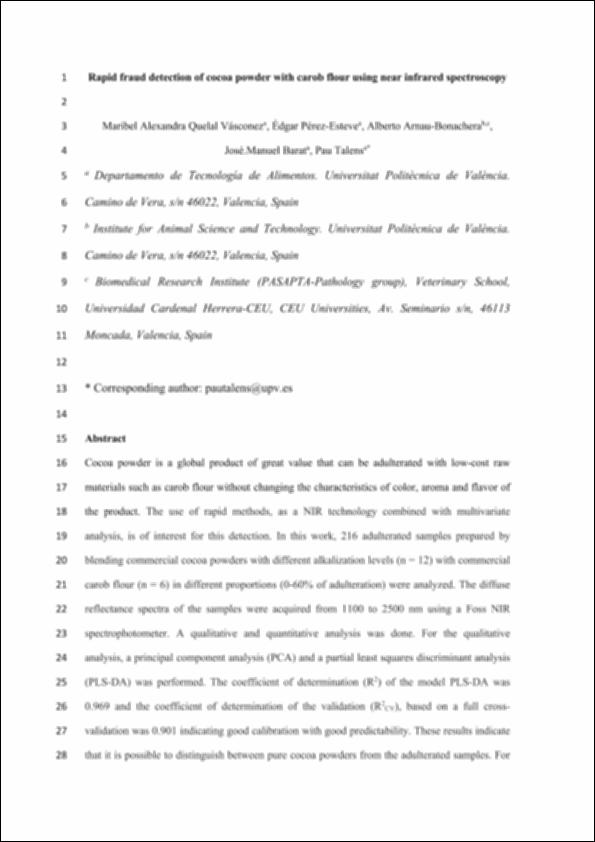Please use this identifier to cite or link to this item:
http://hdl.handle.net/10637/10495Rapid fraud detection of cocoa powder with carob flour using near infrared spectroscopy
| Title: | Rapid fraud detection of cocoa powder with carob flour using near infrared spectroscopy |
| Authors : | Quelal Vásconez, Maribel Alexandra Pérez Esteve, Édgar Arnau Bonachera, Alberto Barat Baviera, José Manuel Talens Oliag, Pau |
| Keywords: | Food - Quality.; Carob flour - Adulteration and inspection.; Harina de algarroba - Adulteración e inspección.; Cocoa - Adulteration and inspection.; Alimentos - Control de calidad.; Cacao - Adulteración e inspección. |
| Publisher: | Elsevier. |
| Citation: | Quelal Vásconez, MA., Pérez Esteve, E., Arnau Bonachera, A., Barat, JM. & Talens, P. (2018). Rapid fraud detection of cocoa powder with carob flour using near infrared spectroscopy. Food Control, vol. 92, pp. 183-189. DOI: https://doi.org/10.1016/j.foodcont.2018.05.001 |
| Abstract: | Cocoa powder is a global product of great value that can be adulterated with low-cost raw materials such as carob flour without changing the characteristics of color, aroma and flavor of the product. The use of rapid methods, as a NIR technology combined with multivariate analysis, is of interest for this detection. In this work, 216 adulterated samples prepared by blending commercial cocoa powders with different alkalization levels (n = 12) with commercial carob flour (n = 6) in different proportions (0-60% of adulteration) were analyzed. The diffuse reflectance spectra of the samples were acquired from 1100 to 2500 nm using a Foss NIR spectrophotometer. A qualitative and quantitative analysis was done. For the qualitative analysis, a principal component analysis (PCA) and a partial least squares discriminant analysis (PLS-DA) was performed. The coefficient of determination (R2) of the model PLS-DA was 0.969 and the coefficient of determination of the validation (R2CV), based on a full cross validation was 0.901 indicating good calibration with good predictability. These results indicate that it is possible to distinguish between pure cocoa powders from the adulterated samples. For the quantitative analysis a partial least squares (PLS) regression analysis was performed. The most robust model of PLS prediction was obtained with 1 factors (LV) at coefficient of determination (R2) of 0.980 and a root mean square error of prediction (RMSEp) of 3.237 % for the external validation set. These data lead to the conclusion that NIR technology combined with multivariate analysis allows the identification and determination of the amount of natural cocoa powder present in a mixture adulterated with carob flour. |
| Description: | Este artículo se encuentra disponible en la siguiente URL: https://www.sciencedirect.com/science/article/pii/S0956713518302263 Este es el pre-print del siguiente artículo: Quelal Vásconez, MA., Pérez Esteve, E., Arnau Bonachera, A., Barat, JM. & Talens, P. (2018). Rapid fraud detection of cocoa powder with carob flour using near infrared spectroscopy. Food Control, vol. 92, pp. 183-189, que se ha publicado de forma definitiva en https://doi.org/10.1016/j.foodcont.2018.05.001 This is the pre-peer reviewed version of the following article: Quelal Vásconez, MA., Pérez Esteve, E., Arnau Bonachera, A., Barat, JM. & Talens, P. (2018). Rapid fraud detection of cocoa powder with carob flour using near infrared spectroscopy. Food Control, vol. 92, pp. 183-189, which has been published in final form at https://doi.org/10.1016/j.foodcont.2018.05.001 |
| URI: | http://hdl.handle.net/10637/10495 |
| Rights : | http://creativecommons.org/licenses/by-nc-nd/4.0/deed.es |
| ISSN: | 0956-7135 |
| Issue Date: | 1-Oct-2018 |
| Center : | Universidad Cardenal Herrera-CEU |
| Appears in Collections: | Dpto. Producción y Sanidad Animal, Salud Pública Veterinaria y Ciencia y Tecnología de los Alimentos |
Items in DSpace are protected by copyright, with all rights reserved, unless otherwise indicated.


